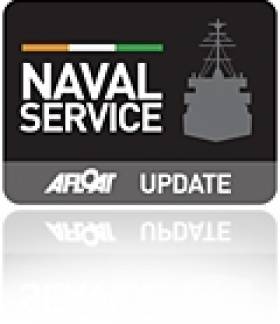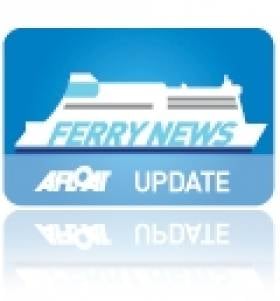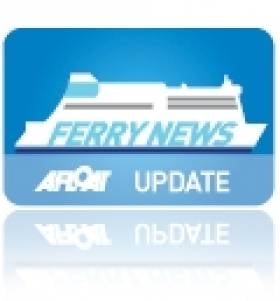Displaying items by tag: Stena Line
The operation was spearheaded by the ARW with the support of a Naval Service coastal patrol vessel (CPV) and also Air Corps helicopters. High-speed tactical assault craft with ARW teams on board conducted manoeuvres while air-borne teams fast-roped from helicopters onto the deck of the Stena Adventurer. To see photos of the ARW team in action click HERE.
The exercise was designed to enhance the capacity of the Defence Forces to provide the State with a highly specialised maritime armed intervention capability.
Last month the Naval Service conducted close quarter manoeuvres in 'Operation Quixote' off the south-west coast. The exercise involved the entire naval fleet except for the flagship LE Eithne, which performed in gunnery practice, simulated air attacks from the Air Corps and armed naval boarding parties.
Stena Line to Resume ‘Express’ Service
In addition to the 'Express' service the St. Georges Channel route is served by the year-round operated conventional ferry, Stena Europe (1981/24,828 grt). The 1,386 passenger / 564-vehicle ferry recently underwent a £2m refurbishment and takes a more leisurely passage time of 3 hours 30 minutes.
For information on both fast-ferry and conventional ferry sailing schedules click HERE.
RMR Shipping Increase Irish-West African Sailings
Dublin Port Company has welcomed RMR Shipping's new increased frequency of its service to West Africa, from a monthly to fortnightly service starting next month, writes Jehan Ashmore.
The direct service which began in 2009 using a single vessel from the capital to Nigeria, Ghana with calls to Lagos and Takoradi, is set to gain a second ship as demand for the service rises.
Two 157-trailer capacity ro-ro sisters are to be deployed on the route, they are the 23,000 gross tonnes sisters Celandine and Celestine. The Belgium-flagged pair both built in 2000 will take 18-days to transit between Dublin and Ghana.
The next sailing to Dublin is due on 5 July when the Celandine (PHOTO) is to dock at berth 51a, which is one of three berths located in the ports multi-user ferryport Terminal 1, shared by Irish Ferries, Stena Line and seasonal services of the Isle of Man Steam Packet Company.
Commenting on the development, Eamonn O'Reilly, Chief Executive Dublin Port Company said: "We are delighted with this development. Anything which increases the link between Ireland and emerging economies beyond Europe has got to be good for exports.
He added, "The service to Takoradi complements our involvement with Irish Aid from 2008 to 2010 in delivering an international training programme for ports in emerging countries including Ghana. The TrainForTrade programme was delivered with UNCTAD and we are hopeful of being able to announce a follow-up to the first programme in the coming months.
The development of RMR Shipping on the direct sea freight link was also welcomed by the Irish Exporters Association (IEA) whose chief executive John Whelan commented that exports to Nigeria last year exceeded €200m, the second largest market for Irish goods into Africa.
Family Fun Day Cruise’s from Belfast
The 'cruise' onboard the ferry Stena Navigator (for virtual tour click HERE) is based on a return excursion on the North Channel route.
So what's included?...there's live music, disco / karaoke, face-painting, balloon modeling and party games for the children. For further family entertainment there's even a magician, Wii-games, free movies and free Wi-Fi.
In addition a 10% discount is available from the onboard shop, though exclusions apply.
Cruises are not catered for vehicles but apply to 'foot' passengers, for further details on terms and conditions, cruise itinerary and travel dates click HERE.
Seasonal Scenes Set for Fishguard
Fast-ferry Stena Lynx III departed Dun Laoghaire for Fishguard Harbour on a repositioning voyage today, writes Jehan Ashmore.
The 80m craft built in Hobart, Tasmania is due to dock at the Pembrokeshire port this afternoon in advance of seasonal sailings on Stena Line's Fishguard-Rosslare.The Stena 'Express' fast-ferry service is to resume in just over a fortnight's time. Sailings are scheduled to a daily single round trip between 1 July-4 September.
The 627 passenger / 120 car capacity fast-ferry will operate in tandem with the year-round operated conventional ferry-service served by the Stena Europe. Passage times are 120 minutes for the fast-ferry service while the Stena Europe takes 3 hours 30 minutes to sail across the St. Georges Channel.
In the same week that the fast-ferry takes up summer sailings from Fishguard, the small French flagged cruiseship Le Diament is to make the first of three calls in July and once in August.
The motoryacht-like vessel which can accommodate 226 passengers is the first cruise caller of the season and is run by the only French-owned cruise operator Compagnie De Iles Du Ponant.
Irish Authorities Approve Stena / DFDS Merger
Of the two services, the Belfast-Liverpool (Birkenhead) is for passengers and freight while the and Belfast-Heysham port route is exclusively for freight-only users. To read more about the decision from the authority click here.
In February the UK's Office of Fair Trading (OFT) referred Stena AB's acquisition from DFDS A/S to the Competition Commission, conclusions on the report are not expected to be made until 25 July. To read more about the merger click here.
In the meantime the Belfast-Liverpool (Birkenhead) route continues trading under the name of Stena Line Irish Sea Ferries Ltd which is separately operated to Stena Line's other Irish Sea routes.
Sailings on the 8-hour route are run by the Italian built 27,510 tonnes ro-pax twins Lagan Seaways and Mersey Seaways which have been in service since the newbuilds were launched in 2005.
As the acquisition remains subject to regulatory clearance, passengers intending to travel on the route can continue to make bookings through the DFDS Seaways website by logging onto this link.
In addition the acquisition involved the sale of the South Korean built freight-ferries Hibernia Seaways and Scotia Seaways which operate Belfast-Heysham sailings.
Stena's Southern Sailings
In the meantime freight-only ferry Stena Seafarer is operating the St. Georges Channel route having arrived at Rosslare on a repositioning voyage from Belfast on 29th March.
Stena Seafarer (1975 / 10,957grt) was one of a trio of freight-ferry sisters that served the Larne-Fleetwood port route until its closure in December. Like her sisters Stena Leader (1975 / 12,879grt) and Stena Pioneer (1975 / 14,426grt) they were built at the West German shipyard of J.J. Sietas in Hamburg.
Stena Seafarer's sisters remain laid-up in Belfast and with each vessel over 35 years in service it would seem likely there are nearing the end of their careers, at least on the Irish Sea.
To provide additional passenger capacity the Stena 'Express' fast-ferry service will return to the southern corridor route between 1 July-4 September. The high-season sailings as usual will be operated by the InCat built Stena Lynx III which is to operate a daily single round trip in tandem with Stena Europe.
HSS Sailings Resumed
The Stena Explorer had completed her first sailing from Holyhead yesterday morning, the fastcraft having departed the Welsh port at 10.00hrs.
Due to the technical difficulties, the Stena Explorer was not in a position to accommodate passengers on the return crossing, though the fastcraft did depart Dun Laoghaire 'light' (without passengers) at 18.45hrs for Holyhead.
The Stena Explorer resumed service with this morning's 10.00hrs sailing from Holyhead to Dun Laoghaire.
The re-introduction of the Stena Explorer is to provide greater capacity during the summer season compared to the smaller Stena Lynx III, which previously served the route until early January. The HSS will operate the two-hour route with a daily single round trip up to 13 Setember.
Stena to Re-Introduce HSS this Week
Stena Line's HSS fast-ferry the Stena Explorer will be re-introduced on its Dun Laoghaire to Holyhead route this Friday, writes Jehan Ashmore.
The HSS (High Speed Service) operated 19,638 tonnes craft will run between 1 April to 13 September to cope with the additional demand over the summer period.
A single daily round trip is scheduled with a 10.00 hours sailing from Holyhead and a 13.15 hours sailing from Dun Laoghaire. Passage time is 120 minutes (2 hours).
The HSS can 350 vehicles and with 1500 passengers, the craft can handle higher volumes of seasonal summer foot passengers compared to the last route serving vessel, the 4,113 tonnes Stena Lynx III. The return of the HSS service links in with those intending to make onward journeys from Dun Laoghaire's DART commuter rail service to Dublin city centre and beyond on the national rail network.
Up to early January the route had been served by the Stena Lynx III which remains moored alongside Dun Laoghaire's St. Michaels Wharf. The craft which can take 627 passengers and 120 cars and marketed as the Stena 'Express' is to resume high season sailings starting in July between Rosslare-Fishguard.
In total the company carries over two million passengers on its four Irish Sea routes each year. An additional route between Belfast-Liverpool (Birkenhead) was taken over by the Swedish owned ferry company from DFDS Seaways late last year, is subject to regulatory clearance.
Until such clearance has been granted, this route will be operated separately from all other Stena Line routes. In the meantime the company advise until further notice to make bookings which will remain acceptable through the use of the DFDS website.
HSS Fast-Craft to Return on Dun Laoghaire Route
According to Stena Line over 70% of its passengers business is carried by the HSS Stena Explorer in the high season. It is felt that the 1996 Finnish built fast-craft is better suited for the service due to a loyal customer base which was reflected by repeat bookings and their preference of the HSS craft on the 120 minute (2 hour) route.
A daily single round trip is scheduled with sailings from Dun Laoghaire to Holyhead departing at 13:15hrs. The corresponding sailing from the Anglesey port departs at 10.00hrs and arrives at the Irish port at 12 noon. Sailings will operate through the summer until 13 September.
From there on Stena will make a decision as to its continuing schedule, though it is widely believed that the prospects of the fuel-thirsty, expensive to run HSS fast-craft service are likely to be at an end of an era.
Last month negotiations over the core issue of harbour fees were held between Stena Line and Dun Laoghaire Harbour Company. It is understood that the annual fee of €6.5m was dropped to €2m. The board of the harbour company has given a 'conditional green light' of a new ferry contract to Stena Line to run the service for the next two years with an option of a third year.
The service closed for its seasonal break earlier this year on 5 January with the 'Lynx' going into temporary lay-up at Holyhead's inner harbour to join the HSS Stena Explorer. The HSS had been 'wintering' at the port since September sailings were taken over by the Lynx.
Earlier this month the Stena Lynx III came to Dun Laoghaire to continue her lay-up period. The 1996 Tasmanian built craft will stay there before resuming seasonal sailings between Rosslare-Fishguard in tandem with the conventional ferry Stena Europe.
In the meantime the craft is berthed at the harbour's two-berth ferry terminal at St. Michaels Wharf. The HSS berth is only designed for this type of fast-craft whereas the other berth now occupied by the Lynx was built originally for conventional ferries but was re-configured last year to suit the fast-craft.






































































